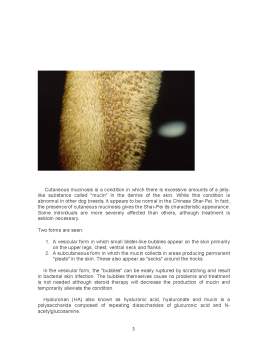Extras din referat
Astenia cutanata
Cutaneous asthenia (dermatosparaxis, Ehlers-Danlos syndrome) is a group of syndromes characterized by defects in collagen production. This results in a variety of clinical signs, including loose, hyperextensible, fragile skin; joint laxity; and other connective tissue dysfunctions. These collagen defects have been described in cattle (Belgian Blue and White, Charolais, Hereford, Holstein-Freisian, Simmental), a goat, sheep (Norwegian Dala, Border Leicester-Southdown, Finnish-Merino cross, Romney, White Dorper), pigs (Large White-Essex cross), horses (Quarter horse, Arabian cross), rabbits (New Zealand white), cats (Himalayan and domestic shorthair), mink, and dogs (a litter of Garafiano Shepherds, sporadically in several breeds).
The mode of inheritance has been demonstrated for Himalayan cats (recessive) and domestic shorthair cats (dominant). Clinical features include fragile skin from the time of birth, wounds that heal with thin scars, delayed wound healing, pendulous skin, and hematoma and hygroma formation. In lambs, rupture of the GI tract and arterial aneurysms are features, and the disease is fatal in lambs and calves. In horses, the onset is later and the lesions are well circumscribed, consisting of hyperextensible and somewhat fragile skin. In dogs and cats, the disease is not fatal, and older animals develop hanging folds of skin and exhibit extensive scarring; some have joint laxity or ocular anomalies.
Diagnosis is based on clinical signs and histopathologic studies of the collagen structure, which require age and breed-matched controls. For diagnosis in cats and dogs, a skin extensibility index has been developed. There are anecdotal reports of improvement of affected dogs with vitamin C supplementation.
The major differential diagnosis in adult cats is feline hyperadrenocorticism with acquired skin fragility.
Fig. Cutaneous asthenia in a 5-mo-old cat.
Mucinoza cutanata
Cutaneous mucinosis is thought to be a familial problem in some lines of Chinese Shar-Peis. Normal Shar-Peis have more cutaneous mucin than other dogs, but in some young dogs, cutaneous mucin formation in the dermis is so excessive that the skin exhibits pronounced folding and mucinous vesiculation.
Diagnosis is by skin prick of the vesicles and observation of the strings of mucus that have the same appearance as normal joint fluid or, alternatively, by skin biopsy.
The syndrome is partially responsive to corticosteroids, but this treatment is contraindicated because of the young age of the affected dogs. As these dogs mature, the severity of the syndrome may abate, but it can be exaggerated by the development of allergic skin disease, which is common in the breed. The major differential diagnosis is hypothyroidism.
Cutaneous mucinosis is a condition in which there is excessive amounts of a jelly-like substance called "mucin" in the dermis of the skin. While this condition is abnormal in other dog breeds, it appears to be normal in the Chinese Shar-Pei. In fact, the presence of cutaneous mucinosis gives the Shar-Pei its characteristic appearance. Some individuals are more severely affected than others, although treatment is seldom necessary.
Preview document
Conținut arhivă zip
- Boli Dermatologice la Animale de Companie.doc




















